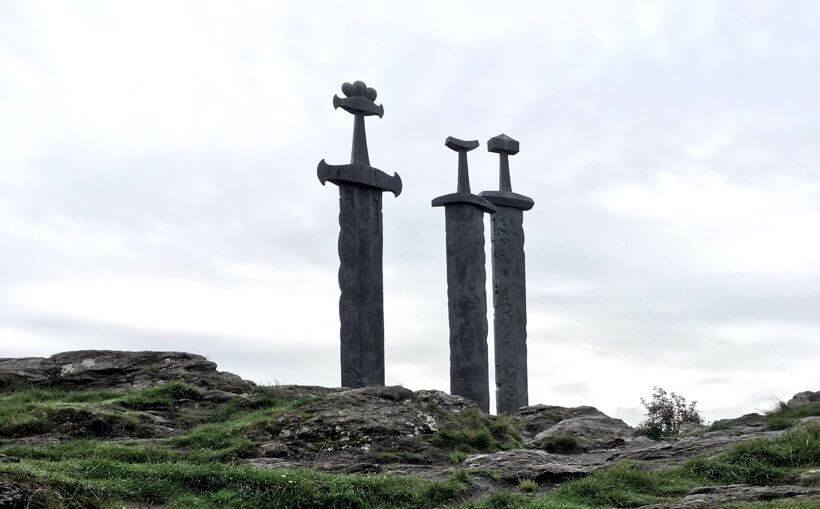Real-World Epicness
What if I told you one of the most legendary RPG landscapes isn’t locked away in a game, but standing tall in the real world – and it’s in Norway?
Picture this: three colossal Viking swords, thrust deep into a rocky hill, overlooking a windswept fjord. It’s not a DLC drop for Skyrim or a hidden level in Elden Ring. It’s Sverd i Fjell – “Swords in the Mountain” – a monument so epic it feels like it was ripped straight from a fantasy saga.
Ready to explore Norway’s ultimate landmark of peace, power, and Viking vibes? Let’s dive in.
The Legend Behind the Blades
Sverd i Fjell isn’t just a cool photo op, it’s a time capsule of Viking history. The monument commemorates the Battle of Hafrsfjord in 872 AD, a brutal clash that ended with King Harald Fairhair uniting Norway under one banner.
Think of it as the final boss fight of the Viking Age, with Harald emerging as the last warrior standing.
So why three swords? Each blade tells part of the story: one for peace, one for unity, and one for strength. The tallest sword, towering at nearly 10 meters, symbolizes Harald’s victory, while the two smaller ones nod to the defeated chieftains. Together, they mark the moment Norway became whole.
It’s less “loot drop” and more “world-changing lore,” etched into the landscape for centuries to come.
Symbolism and Design
Crafted by Norwegian sculptor Fritz Røed and unveiled in 1983, Sverd i Fjell is as much art as it is history. The swords aren’t just stuck in the ground for kicks, their burial in stone is a deliberate nod to peace. These blades will never be drawn again, a silent vow that the wars of old are over.
The design pulls from real Viking swords, with broad, weathered blades that whisper of raids, sagas, and stormy seas. Røed’s creation blends raw power with quiet grace, making it feel both ancient and timeless, like a relic you’d uncover in a forgotten crypt.
Forged in Bronze: How Sverd i Fjell Was Built
The creation of Sverd i Fjell was a true feat of artistic vision and engineering muscle.
Fritz Røed designed the swords with historical accuracy in mind, each hilt inspired by actual Viking sword finds from different regions of Norway. The tallest sword, representing Harald’s triumph, stands 9.2 meters (about 30 feet) high, while the two smaller blades represent his fallen rivals. All are cast in bronze, a heavy, weather-hardened metal, with each sword weighing over a ton.
To install them, engineers drilled deep sockets into solid rock at Møllebukta Bay near Stavanger. Massive cranes hoisted and secured the swords, planting them like they’d been there since the Viking Age. And while there’s no step-by-step construction log floating around, one thing’s clear: this wasn’t a backyard DIY job. It was a legendary effort worthy of the story it tells.
RPG Feels and Cultural Magic
Let’s be real: Sverd i Fjell looks like it belongs in a game. The towering swords, the rugged fjord backdrop, the moody Nordic sky – it’s Skyrim’s High Hrothgar meets The Witcher’s Kaer Morhen. You can almost hear the lute music or feel the weight of a quest scroll in your inventory.
Imagine the setup: a grizzled NPC stands by the blades, spinning tales of Harald’s triumph, then tasks you with retrieving a lost relic from the fjord’s depths. Cue the dramatic music and a boss fight with a spectral draugr. Sold yet?
It’s not just the visuals. The monument’s mix of natural beauty, crashing waves, mossy rocks, and mythic design taps into Norway’s deep cultural magic. This is a land where history feels alive, where every stone could hide a story. Sverd i Fjell doesn’t just stand there; it commands the landscape like a sentinel from a forgotten age.
Myths, Magic, and Modern Legends
Even though the monument is relatively new, built in 1983, it’s already sparked a wave of myths and modern legends — some rooted in history, others pure fantasy.
🧝♂️ Harald and the Hair Vow
Legend says Harald Fairhair swore not to cut or comb his hair until he ruled all of Norway. A vow made to impress a strong-willed noblewoman named Gyda. After uniting the land, he became known as “Fairhair.” Some romantics say Sverd i Fjell marks not just unity, but Harald’s triumph for love.
🔮 The Magic Swords Myth
Locals (and a few creative tour guides) whisper that the swords are enchanted relics, sealed into stone by Viking sorcery to guard the nation’s peace. History says otherwise, it was heavy machinery, not magic, but let’s not ruin the vibe.
🧌 The Troll King’s Gift
A lesser-known tale claims the swords were forged by a troll king who ended a feud with Harald by gifting him the weapons and burying them in the rock as a peace pact. Totally mythical, but with Norway’s love for trolls, who’s to say?
☠️ The Eternal Peace Curse
Some say if the swords are ever removed, Norway’s unity will fall apart. Whether it’s superstition or symbolic warning, it adds another layer to the monument’s quiet power.
Visiting Sverd i Fjell
Ready to step into the real-life? Sverd i Fjell sits just outside Stavanger, a charming coastal city in southwestern Norway. It’s an easy 15-minute drive from the city center to the Hafrsfjord shore, where the swords await.
The site’s free to visit, fully accessible, and perfect for a quick stop or a longer linger. The vibe? Quietly epic, think windswept serenity with a dash of Viking gravitas. Spring or summer offers the best weather, but a moody autumn visit could amp up those cinematic feels.
Nearby, adventurers can:
- Stroll Stavanger’s cobblestone Old Town
- Hike to Preikestolen (Pulpit Rock)
- Cruise the stunning Lysefjord
A treasure trove of side quests for any traveler bold enough to take them on.
What It Teaches Us Today
From war to peace, sword to stone, battle to unity — Sverd i Fjell is more than a monument; it’s a lesson carved in steel and rock.
What started as a clash of blades ended with a symbol of togetherness, a reminder that even the wildest wars can give way to calm. Today, it stands as proof of the lasting power of symbols: simple, bold, and unforgettable.
In a world that often feels like it’s one bad roll away from chaos, Norway’s swords whisper that peace is worth fighting for, and worth keeping.

